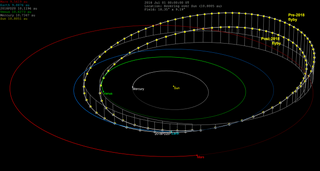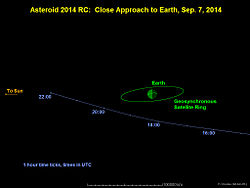
(276033) 2002 AJ129, provisional designation 2002 AJ129, is a Mercury-crossing asteroid. It has the ninth-smallest perihelion of all numbered asteroids, after asteroids such as 2000 BD19, 2004 UL, and 2008 XM. It makes close approaches to all of the inner planets and asteroid 4 Vesta. The asteroid is estimated to be between 0.5–1.2 kilometers (0.3–0.7 mi) across. In January 2018 there was much media hype about this asteroid being classified as a potentially hazardous asteroid, although there is no known threat of an impact for hundreds if not thousands of years. The media has compared the size of the asteroid to the Burj Khalifa in Dubai.
(529366) 2009 WM1, provisional designation 2009 WM1, is a sub-kilometer asteroid and near-Earth object of the Apollo group, approximately 280 meters (920 feet) in diameter. After its discovery by the Catalina Sky Survey at the Catalina Station in Arizona, United States, this potentially hazardous asteroid was briefly listed at a Torino Scale of 1 and a cumulative Palermo Scale of −0.87. It was removed from the Sentry Risk Table on 26 June 2013.

2012 BX34 is a small Aten asteroid that made one of the closest recorded asteroid close approaches of Earth on 27 January 2012. It passed within 0.0004371 AU (65,390 km; 40,630 mi) of Earth during its closest approach at 15:25 GMT. 2012 BX34 measures around 8 meters (26 ft) across; if it had impacted in 2012, it would have been too small to pass through Earth's atmosphere intact.
(471240) 2011 BT15, provisional designation 2011 BT15, is a stony, sub-kilometer sized asteroid and fast rotator, classified as a near-Earth object and potentially hazardous asteroid of the Apollo group. It had been one of the objects with the highest impact threat on the Palermo Technical Impact Hazard Scale.
2012 KP24 (also written 2012 KP24) is a Chelyabinsk-sized near-Earth asteroid with an observation arc of only 5 days and has a modestly determined orbit for an object of its size. Around 31 May 2023 ±3 days it will pass between 0.19–24 lunar distances (73,000–9,200,000 km) from Earth. Nominally the asteroid is expected to pass 0.026 AU (3,900,000 km; 10 LD) from Earth and brighten to around apparent magnitude 21.6.
2011 XC2 (also written 2011 XC2) is a near-Earth asteroid roughly 60–140 meters (200–460 ft) in diameter that passed less than 1 lunar distance from Earth on 3 December 2011.
2010 XG11 is an Amor near-Earth asteroid. It was discovered on 5 December 2010 by the Catalina Sky Survey at an apparent magnitude of 19.7 using a 0.68-meter (27 in) Schmidt–Cassegrain telescope. Three precovery images are known from 1 July 1995. With an observation arc of 16 years, the orbit is well determined with an orbital uncertainty of 0. With an absolute magnitude of 20.0, the asteroid is about 270–590 meters in diameter.
2014 SC324 is a sub-kilometer asteroid and fast rotator, classified as a near-Earth object of the Apollo group, approximately 50 meters in diameter. It was first observed on 30 September 2014, by the Mount Lemmon Survey at an apparent magnitude of 21 using a 1.5-meter (59 in) reflecting telescope. With an absolute magnitude of 24.3, the asteroid is about 37–85 meters in diameter.

2012 TC4 is a tumbling micro-asteroid classified as a bright near-Earth object of the Apollo group, approximately 10 meters (30 feet) in diameter. It was first observed by Pan-STARRS at Haleakala Observatory on the Hawaiian island of Maui, in the United States. As of 1 October 2017, it had a small Earth minimum orbital intersection distance of 0.000149 AU (22,300 km). On 12 October 2017, it passed Earth at 0.00033524 AU (50,151 km). The asteroid was removed from the Sentry Risk Table on 16 October 2017 and with a 5-year observation arc has a well-known orbit. For example, on the previously risk-listed date of 12 October 2022, it is now known that the asteroid will be more than 3 AU (450 million km) from Earth.
2014 UR116, also known as 2008 XB, is an eccentric sub-kilometer asteroid, categorized as a near-Earth object and potentially hazardous asteroid of the Apollo group with a diameter of approximately 400 meters (1,300 ft). It was first observed on 1 December 2008, by the Mount Lemmon Survey at Mount Lemmon Observatory in Arizona, United States.
2007 VE191 is a sub-kilometer asteroid, classified as near-Earth asteroid of the Apollo group that was listed on the Sentry Risk Table.
2014 XL7 is a near-Earth object and Apollo asteroid, approximately 230 meters (750 feet) in diameter. It was the most dangerous potentially hazardous asteroid on Sentry Risk Table upon its discovery by the Mount Lemmon Survey in December 2014. At the time, the asteroid had a cumulative 1 in 83000 chance of impacting Earth on 4–5 June between the years 2048 and 2084. After the object's observation arc had been extended to 35 days, it was removed from the Sentry Risk Table on 15 January 2015. Since then the asteroid's orbit has been secured. Although it has an Earth minimum orbit intersection distance of less than one lunar distance, there are no projected close encounters with Earth in the foreseeable future, with its closest passage to occur in May 2046, still millions of kilometers away.
2015 AZ43 (also written 2015 AZ43) is an Apollo near-Earth asteroid roughly 70 meters in diameter. On 10 February 2015 with a 29.5-day observation arc, it showed a 1 in 5,880 chance of impacting Earth on 27 February 2107. However, the NEODyS nominal best-fit orbit shows that 2015 AZ43 will be 2.8 AU (420,000,000 km; 260,000,000 mi) from Earth on 27 February 2107. A (non-impacting) Earth close approach in 2056 makes future trajectories diverge. It was removed from the JPL Sentry Risk Table on 23 February 2015 using JPL solution 26 with an observation arc of 40 days that included radar data.
2012 UE34 is a sub-kilometer asteroid, classified as a near-Earth object of the Apollo group, approximately 70 meters (230 feet) in diameter. It was first observed on 18 October 2012, by Pan-STARRS at Haleakala Observatory on the island of Maui, Hawaii, in the United States. The object was removed from the Sentry Risk Table on 29 December 2013. On 8 April 2041 it will pass Earth at a nominal distance of 0.0007329 AU (110,000 km; 68,000 mi). Due to its presumed small size, it does not qualify as a potentially hazardous asteroid, despite its low Earth MOID.

2015 TB145 is a sub-kilometer asteroid, classified as near-Earth object and potentially hazardous asteroid of the Apollo group, approximately 650 meters (2,000 feet) in diameter. It safely passed 1.27 lunar distances from Earth on 31 October 2015 at 17:01 UTC, and passed by Earth again in November 2018.
2013 TX68 is an Apollo asteroid and near-Earth object discovered on 6 October 2013 by the Catalina Sky Survey, during which it was near a close approach of 5.4 Lunar distances (LD) from the Earth. The asteroid only has a 10-day observation arc which makes long-term predictions of its position less certain. It was observed for three days as it approached Earth in the night sky starting with the sixth of October, 2013. Then it became unobservable by being between the Earth and the Sun, then not recovered due to its small size and dimness. Precovery images by Pan-STARRS from 29 September 2013 were announced on 11 February 2016 that extended the observation arc to 10 days. It was removed from the Sentry Risk Table on 11 February 2016, so there is no risk of impact from this object for the next hundred years or more. The asteroid was last observed on 9 October 2013.
2017 TD6 is a micro-asteroid, classified as a near-Earth object of the Apollo group, approximately 10–20 meters in diameter. It was first observed by Pan-STARRS at Haleakala Observatory, Hawaii, on 11 October 2017.
2017 VW13 is an Apollo near-Earth asteroid roughly 250 meters (820 feet) in diameter. It was discovered on 13 November 2017 when the asteroid was about 0.069 AU (10,300,000 km; 6,400,000 mi) from Earth and had a solar elongation of 110 degrees. Ten days earlier, on 3 November 2017, the asteroid had passed 0.02818 AU (4,216,000 km; 2,619,000 mi) from Earth, but only had a solar elongation of 65 degrees.

2018 PD20 is a small asteroid, classified as a near-Earth object of the Apollo group, approximately 9–20 meters (30–66 feet) in diameter. On 11 August 2018, it was first observed by ATLAS at the Mauna Loa Observatory on Hawaii (T08), when it passed 33,500 kilometers (20,800 miles) from the Earth. This is notable because it came within a tenth of the lunar distance, or 0.10 LD which is closer to Earth than satellites in a geostationary orbit. These have an altitude of 0.11 LD, about 36,000 km (22,000 mi), approximately 3 times the width of the Earth.
2020 SW is a tiny near-Earth asteroid discovered by the Mount Lemmon Survey on 18 September 2020, six days before it made its closest approach to Earth. The asteroid passed within 21,600 kilometres (13,400 mi) from Earth's surface on 24 September 2020 11:13 UT, within the geostationary altitude of 36,000 kilometres (22,000 mi). The encounter with Earth perturbed the asteroid's heliocentric trajectory from an Apollo-type orbit to an Aten-type orbit with a semi-major axis within one astronomical unit from the Sun. As a result, the asteroid will not make any close approaches to Earth within 0.01 astronomical units (4 LD) in the next 200 years.










